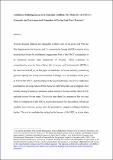Confidence-building measures in Eurasian conflicts : new roles for the OSCE’s economic and environmental dimension in easing East-West tensions
Date
2019Metadata
Show full item recordAbstract
Western-Russian relations are inarguably at their worst of the post-Cold War era. The Organisation for Security and Co-operation in Europe (OSCE) remains a key international forum for multilateral engagement. Part of the OSCE’s uniqueness is its formation around three dimensions of security, which constitute its comprehensive security. The Economic and Environmental (EED) is the most overlooked yet, as this paper demonstrates, also possesses substantial capacity for easing some tensions. Through, first, an analysis of the place of EED in the OSCE, and thus between the West and Russia, the article establishes potentialities for cooperation. Second, it identifies lack of support, most notably among Western governments, rather than post-Soviet, and the place of EED activities in post-Soviet states. Third, the article pinpoints unexpected but very real forms of cooperation in the EED in the protracted post-Soviet conflicts of Transnistria-Moldova and Abkhazia-Georgia, which can establish trust between parties with the potential to expand confidence-building further. The article concludes by calling for further use of the EED, in a time when it remains underestimated but of unexpected – and essential – value for confidence-building.
Citation
Fawn , R & Lutterjohann , N 2019 , ' Confidence-building measures in Eurasian conflicts : new roles for the OSCE’s economic and environmental dimension in easing East-West tensions ' , Global Society , vol. 33 , no. 2 , CGSJ-2018-0038 , pp. 262-284 . https://doi.org/10.1080/13600826.2019.1566214
Publication
Global Society
Status
Peer reviewed
ISSN
1360-0826Type
Journal article
Description
Funding was provided by the Friedrich Ebert Foundation Vienna.Collections
Items in the St Andrews Research Repository are protected by copyright, with all rights reserved, unless otherwise indicated.

